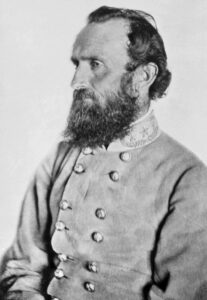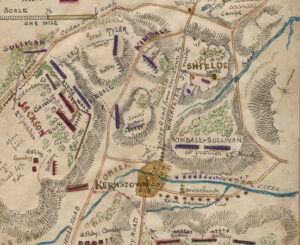About Publications Library Archives
heritagepost.org

Preserving Revolutionary & Civil War History

Preserving Revolutionary & Civil War History

In the spring of 1862, Major General George B. McClellan was preparing to launch his much-anticipated Peninsula Campaign against the Confederate capital at Richmond, Virginia. Besides McClellan’s primary command, three Union forces to the northwest prepared to move south through the Shenandoah Valley to support the invasion.

Opposing the three federal armies was a small Confederate force commanded by General Thomas “Stonewall” Jackson. Comprising the left wing of General Joseph Johnston’s Confederate Army of the Potomac (soon to become the famed Army of Northern Virginia), Jackson reported the size of his command as 4,297 infantry, 369 artillery, and 601 cavalry. As the Peninsula Campaign began, Johnston ordered Jackson to prevent the federal armies in the Shenandoah area from reinforcing McClellan.
The Shenandoah Valley Campaign of 1862 began on February 27, when Major General Nathaniel Banks, Union commander of the Department of the Shenandoah, led much of the 5th Corps of the Army of the Potomac (over 20,000 soldiers) across the Potomac River near Harpers Ferry and into Virginia. Banks’ aim was to move south, up the Shenandoah Valley, toward Richmond, to support McClellan’s offensive.
Jackson was headquartered at Winchester, roughly thirty miles south of Harpers Ferry. Faced with the overwhelming size of Banks’ force, Jackson abandoned Winchester on March 11, 1862. Union forces occupied the town unopposed the next day.
Following Jackson’s withdrawal, Union strategists ordered Banks to divide his command and to send two of his three divisions east to replace troops preparing to support McClellan’s offensive. Brigadier General James Shields, commanding Banks’ 2nd Division, remained in the Shenandoah Valley to deal with Jackson.
On March 21, Jackson received faulty information that Shields’ division, encamped near Winchester, comprised just 3,000 men. Believing the size of the opposing forces to be more balanced, Jackson ordered two grueling forced marches back toward Winchester.
On March 22, Jackson’s cavalry, led by Colonel Turner Ashby, engaged Union pickets near Winchester. When General Shields rode out to assess the situation, a Confederate shell exploded nearby, injuring his chest and shoulder. Shields traveled to a hospital near Winchester and Colonel Nathan Kimball assumed command of the division.

Kimball quickly identified the force to his front as Jackson’s cavalry and correctly determined that Jackson was moving north toward Winchester. Kimball countered by establishing a line across the Valley Turnpike near the village of Kernstown, three miles south of Winchester. Kimball located his field headquarters and artillery batteries on Pritchard’s Hill, a small elevation just to the right of the road. From that vantage point, Kimball had an excellent view of troop movements near the turnpike.
On March 23, Ashby probed the Confederate line throughout the morning. Jackson arrived on the scene at approximately 1 p.m. and deployed his artillery on Sandy Ridge, an elevation west of the Union headquarters. When Jackson visited the site later in the afternoon, his view disclosed that he was facing a federal division of approximately 8,500 men, rather than the 3,000 Yankees that he expected. Supposedly, Jackson remarked, “We are in for it.” Events later in the day proved him to be correct.
Upon learning that Northerners out-manned his command, Jackson called off his planned assault. Instead, he deployed his troops in a defensive position along Sandy Ridge and began shelling the Union headquarters on Pritchard’s Hill.
The Rebel bombardment prompted Kimball to order an assault on Sandy Ridge. The Confederates held the better ground, being deployed behind a stone wall. The Federals, however, had more men. The Rebels held their position until nearly 6 p.m. when they ran low on ammunition. Faced with the possibility of being overrun, Brigadier General Richard B. Garnett ordered his men to abandon the ridge. As Garnett’s men fell back, other Confederates joined the withdrawal, and the retreat became a rout. The fighting ended when night fell.
Upon learning of the Union victory, General Banks rushed to the scene and took charge the next day. Banks ordered a token pursuit of the fleeing Confederates, but he failed to press the issue, enabling Jackson to escape. Jackson retreated up the valley (southward) as far as Mount Jackson near New Market.
Jackson arrested Garnett for ordering the retreat at Sandy Ridge without Jackson’s authorization. The charges eventually went before a court-martial, but the court never rendered a verdict. Robert E. Lee restored Garnett to duty prior to the Battle of Antietam (September 17, 1862).
Despite his arrest, Garnett harbored no ill-will toward Jackson. After Jackson’s death at the Battle of Chancellorsville (April 30–May 6, 1863), Garnett served as a pallbearer at Jackson’s funeral. Garnett died less than two months later at the Battle of Gettysburg (July 1–3, 1863).
The Confederate loss at the First Battle of Kernstown was Jackson’s only defeat as commander of a large force during the Civil War. Rebel losses were 718 (eighty killed, 375 wounded, and 263 missing/captured), compared with Union casualties totaling 590 (118 killed, 450 wounded, and twenty-two missing or captured).
After the battle, officials promoted Kimball to the rank of brigadier general. Nonetheless, the Union victory turned out to be a strategic success for the Confederacy. Overly concerned about the possibility of Jackson launching an assault upon the nation’s capital, President Lincoln ordered Union troops back into the Shenandoah Valley. Thus, Jackson achieved his goal of keeping Banks’ army from supporting McClellan’s Union offensive against Richmond.